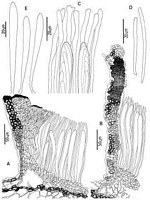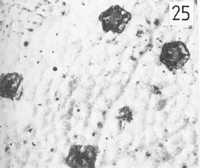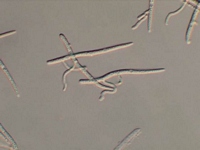|
 Coccomyces lauraceus Coccomyces lauraceus
BiostatusPresent in region - Indigenous. Non endemic
Images (click to enlarge)
Caption: Fig. 8 Coccomyces lauraceus: A, ascocarp margin in cross-section. B, immature ascocarp
margin in cross-section. C, apices of asci and paraphyses. D, released ascospores. E, asci. | 
Caption: Fig. 25 Macroscopic appearance of ascocarp (x 12).
C. lauraceus; | 
Caption: ascospores germinating on agar, 6 days.
Owner: P.R. Johnston |
Article: Johnston, P.R. (1986). Rhytismataceae in New Zealand. 1. Some foliicolous species of Coccomyces de Notaris and Propolis (Fries) Corda. New Zealand Journal of Botany 24(1): 89-124 (http://www.rsnz.org/publish/abstracts.php).
Description: Ascocarps developing on both upper and lower leaf surfaces, within pale, yellowish lesions
on fallen leaves. Lesions often surrounded by narrow, black zone lines, although these are
sometimes not present around young lesions. Ascocarps angular in outline, 3-5 sided , 0.6-1.3
mm diam. Immature ascocarps with dark grey to black walls, faint preformed lines of
dehiscence, and sometimes with a paler zone adjacent to outer edge of ascocarp, which is
marked by a black line. Mature ascocarps dark brown to black walled, wall usually extending
in a narrow, flat, finely scalloped plate around the edge. Lip cells often present, hyaline in
young ascocarps, becoming dark with age. Hymenium pale yellow when exposed. Pycnidia
absent.
Ascocarps intraepidermal. In vertical section upper stromatal layer 20-80 µm wide,
becoming wider around opening. Wall composed of dense, black tissue around opening
ascocarp, otherwise of brown to pale brown, pseudoparenchymatous cells, 4-7 µm diam. Lip
cells cylindric, hyaline, becoming dark brown, embedded in gel. Short, hyaline periphyses
often present, lining the upper wall. Lip cells and periphyses often elongating and becoming
septate, forming an extensive excipulum-like layer in older ascocarps. Lower stromatal layer
joining the upper, 8-15 µm wide, of 2-3 layers of thick walled, dark brown cells, 2.5-4 µm
diam. Subhymenium 19-30 µm wide, of hyaline, thin walled cells, 3-6 µm diam.
Paraphyses 2-2.2 µm diam., becoming slightly swollen at apices, 3-4.5 µm diam.,
extending 10-20 µm beyond asci. Asci subclavate, gradually tapering toward the base from
near the apex, tapering at top to a more or less acute apex, uniformly thin walled, 104-142 x
7.5-11 µm, non-amyloid, 8-spored. Ascospores acicular, 41-60 x 2.2-3 µm, tapering
slightly to the basal end, 0-septate, poorly developed gelatinous sheath.
Habitat: Found on recently fallen leaves of Beilschmiedia tawa, B. tarairi (A. Cunn.)
Benth. et Hook. f. ex Kirk, and Litsea calicaris.
Notes: ETYMOLOGY: lauraceus; refers to host plant family.
NOTES: C. lauraceus is more or less intermediate between C delta (Kunze) Saccardo, and C.
dentatus (Kunze & Schmidt:Fries) Saccardo, two species discussed by Sherwood (1980). All
three species have subclavate asci and paraphyses with slightly swollen apices.
C lauraceus agrees well with C. delta (Azores, Sao Miguel, Hickling Park, on Lauraceae, R.
P. & N. Korf, L. M. Kohn, A. Y. Rossman, 5.IV. 1978 CUP-MM1845; Canary Is., La Palma,
Los Tilos, on Ocotea sp., R. P. Korf, W. C. Dennison, L. M. Kohn, M. A. Sherwood,
14.1.1976 - CUP-MM654; ibid., on Laurus sp. - CUP-MM647; Madiera, Chao dos Louros,
on Lauraceae, R. P. & N. Korf, L. M. Kohn, A. Y. Rossman, 26.IV.1978 - CUPMM2455) in
possessing lip cells, in lacking pycnidia, in ascus size, and in being found exclusively on
Lauraceae. It differs from C. delta in having periphyses which develop into an excipulum-like
layer, and in having significantly shorter and broader ascospores (41-60 x 2.2-3 µm versus
80-100 x 2 µm).
The ascospore length of C. lauraceus matches that of C. dentatus (Sydow, Mycotheca
Germanica 1249- PDD; USA, Oregon, on Castanopsis sp., Sherwood, 8.Vlll. 1978 - FH; Ellis
and Everhart, North American Fungi 3336, on Berberis sp. - PDD). However, C. dentatus
lacks lip cells, is associated with pycnidia, has shorter asci (80-105 µm), and, according to
Sherwood (1980) is found on a wide range of host plants.
This is the only Coccomyces species found on Lauraceae in New Zealand.
|